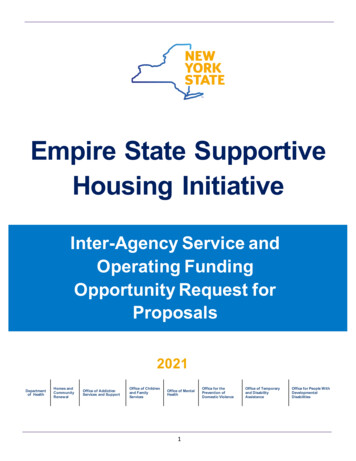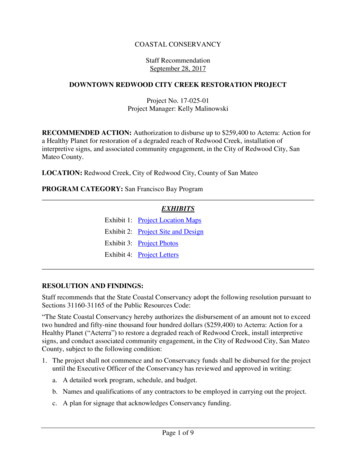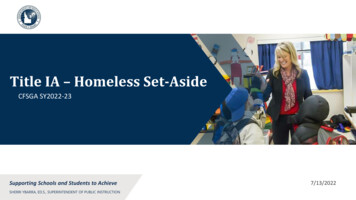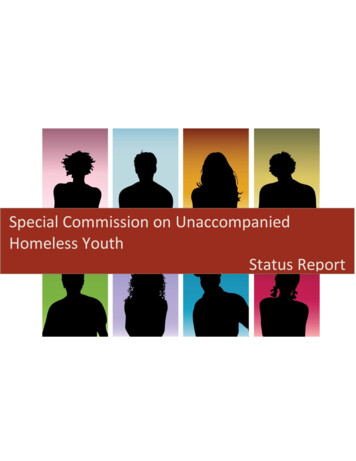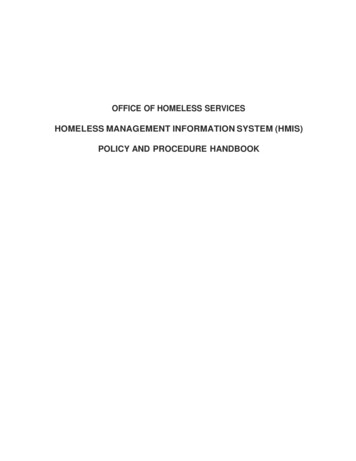
Transcription
OFFICE OF HOMELESS SERVICESHOMELESS MANAGEMENT INFORMATION SYSTEM (HMIS)POLICY AND PROCEDURE HANDBOOK
Participation EligibilitiesIntroductionThe Department of Housing and Urban Development (HUD) recognized thatimplementing a Homeless Management Information System (HMIS) is adifficult and time-consuming process, and must necessarily be done instages. Participation eligibilities and priories were determined by thefollowing: First priority is to bring on board emergency shelters, transitional housingprograms, and outreach programs. Providers of emergency shelter,transitional housing, and homeless outreach services should be includedin the HMIS as early as possible, regardless of whether they receivefunding through the McKinney-Vento Act or from other sources.As a second priority, HUD encourages the Continuum of Care (CoC) toactively recruit providers of permanent supportive housing funded byHUD McKinney-Vento Act programs and other HUD programs.As a third priority , CoC should recruit homeless prevention programs,Supportive Services Only programs funded through HUD's SupportiveHousing Program, and non-federally funded permanent housingprograms.OHSPHB #0009 (03/13)HOMELESS MANAGEMENT INFORMATION SYSTEM (HMlS)8-4
Participation RequirementsAdherence topoliciesAll Homeless Management Information System (HMIS) participatingagencies must agree to the policies in this document in order to participate inthe San Bernardino County Continuum of Care (SBC CoC) HMIS. A signedagreement is required of all end users and participating agencies .Thissection details technical, staffing assignments and training that must befulfilled prior to being granted access to the system.This Policies and Procedures Manual and all attachments may be amendedas needed at any time. Participating Agencies will be notified of any changesand/or amendments to the Policies and Procedures Manual.ParticipatingAgenciesParticipating Agencies are homeless service providers and other ReferringAgencies that utilize SBC CoC HMIS for the purposes of data entry, dataediting, data reporting and referral. Relationships between the SBC CoC andParticipating Agencies are governed by any standing agency-specificagreements or contracts already in place, the HMIS Participating AgencyMemorandum of Understanding (MOU), and the contents of the HMISPolicies and Procedures Manual. All Participating Agencies are required toabide by the policies and procedures outlined in this Manual.Prior to obtaining access to SBC CoC HMIS, every agency must adopt thefollowing documents : Housing and Urban Development (HUD) Data and TechnicalStandards HMIS Participating Agency MOU - The agreement made between theParticipating Agency Executive Management and the Office of HomelessServices (OHS), which outlines agency responsibilities regardingparticipation in the HMIS. This document is legally binding andencompasses all state and federal laws relating to privacy protectionsand data sharing of client specific information. Interagency Data Sharing Agreement - Must be establishedbetween agencies if sharing of client level data above and beyond theminimum shared elements (Central Intake) is to take place. Client Consent/Information Release Forms- To be implementedand monitored by agencies and would require clients to authorize inwriting the entering and/or sharing of their personal informationelectronically with other Participating Agencies throughout SBC CoCHMIS where applicable . HMIS End-User Policies and Procedures- Signed by each HMISEnd-User and the user will agree to abide by standard operatingprocedures and ethics of HMIS. Privacy Notice - Each Participating Agency will post a writtenexplanation describing the agency's privacy policies regarding dataentered into SBC CoC HMIS. Client Revocation of Consent to Release Information Form- Clientrevokes permission to share or release personal information in SBC CoCHMIS.Continued on next pageOHSPHB #0010 (05/13)HOMELESS MANAGEMENT INFORMATION SYSTEM (HMIS)8-5
Participation Requirements, ContinuedParticipatingagency (continued) Grievance Form - The client has a right to file with the HMISLead Organization if he/she feels that the Participating Agency hasviolated his/her rights.Transfer of Data Agreement (if applicable) - The agreement madebetween the Participating Agency Executive Director and OHS tointegrate, upload, or migrate data from the agency's existing system toSBC CoC HMIS.Termination of Employee - This form is to notify the HMIS SystemAdministrator that the referenced employee will no longer work for theorganization and thus all access to the HMIS needs to be revoked.All agencies will be subject to periodic on-site security monitoring to validatecompliance of the agency's information security protocols and technicalstandards.TechnicalstandardsOHS, as the HMIS Lead Organization is responsible for each ParticipatingAgency's oversight and adherence to HUD's Technical Standards as follows:High Speed internet access: DSL, Cable, T1 Line, etc.No dial up connectionsDedicated IP address is recommended- DHCP may be used- Static IP address will be required if the administrative burden of usingDHCP becomes too greatPC w/ lnternet Explorer 5.5 or higher: No Netscape, Mozilla, AOL, etc.No Mac's, UNIX, Linux, etc.Microsoft .NET Framework Version 2.0 or higher: Can be downloaded from www .microsoft.com/downloadsWindows NT sp6a, Windows XPIf running XP we recommend running SP2Firewall: Must use Network Address Translation (NAT) behind firewallIf wireless is used must be protected with at minimum Wired EquivalentPrivacy (WEP)Must be placed between any internet connection and PC for the entirenetworkAntivirus on ALL systems connected to an agency's network: Must have most recent Virus Security UpdatesThis includes systems which Terminal or VPN into the networkContinued on next pageOHSPHB #0009 (03/13)HOMELESS MANAGEMENT INFORMATION SYSTEM (HMIS)8-6
Participation Requirements, ContinuedStaffingresponsibilitiesEach Participating Agency will need to have staff to fulfill the following roles.The responsibilities assigned to these individuals will vary. However, allfunctions must be assigned and communicated to the HMIS htresponsibility forall activitiesassociated withagency'sparticipation inOHS Outcome/Program Managerand/or AgencyAdministratorInternal agencyresource foroutcomemanagementplanning andimplementation FunctionsSigns the HMIS Participating MOU and any otherrequired forms prior to accessing SBC CoC HMIS.Authorizes data access to agency staff and assignsresponsibility for custody of the data.Establishes, adopts and enforces business controlsand agrees to ensure organizational adherence toSBC CoC HMIS Policies and Procedures.Communicates control and protection requirementsto HMIS Users and other agency staff as required.Assumes responsibility for the integrity andprotection of client-level data entered into thesystem .Assumes liability for any misuse of the software byagency staff.Assumes responsibility for posting Privacy Notice.Assumes the responsibility for the maintenance anddisposal of on- site computer equipment.Provides written permission to the HMIS SystemAdministrator to perform the decryption of data toupgrade SBC CoC HMIS technology.Provides written permission to the HMIS SystemAdministrator to perform the decryption of agencydata to upgrade SBC CoC HMIS database serverto new technology when the database becomesobsolete.Periodically reviews system access controldecisions.Serves as the liaison between agency managers,HMIS Users and Outcome Specialists.Attends required Outcomes Management training,Agency Administrator training, and TechnicalAssistance (TA) sessions.Develops and enters into SBC CoC HMIS theoutcome performance targets and milestones.Reports system problems and data-relatedinconsistencies to HMIS System Administrator orOutcome Specialist as needed.Attends HMIS End User Meeting.Continued on next pageOHSPHB #0010 (05/13)HOMELESS MANAGEMENT INFORMATION SYSTEM (HMIS)8-7
Participation Requirements,ContinuedStaffing responsibilities (continued)FunctionsRoleHMIS End User TrainingCompletes training on the appropriate use of SBCCoC HMIS prior to accessing the system.Acknowledges an understanding of this Policiesand Procedures Manual.Adheres to any agency policies that affect thesecurity and integrity of client information.Is responsible for SBC CoC HMIS Data Quality.Data quality refers to the timeliness of entry,accuracy and completeness of informationcollected and reported in HMIS.Signs HMIS End-User Policies and Proceduresand any other required forms prior to accessingsystem.Reports system problems and data-relatedinconsistencies to Agency Administrator orOutcome Manager as appropriate.If applicable, obtains client signature on ClientConsent/Information Release Form.Gives client written copy of Statement of ClientRights.Verbally communicates client's rights and uses ofclient's data.All HMIS Users must complete training appropriate to their functions asdescribed in Item B. Staff Responsibilities prior to gaining access to SBCCoC HMIS. OHS will provide training to all users at the beginning of theagency's SBC CoC HMIS implementation and periodic refresher training forother users as needed.Identified training tracks include: Outcomes Management TrainingPrivacy/Ethics TrainingData Security TrainingData Quality TrainingHMIS User's Trai.ningBed Utilization TrainingReport TrainingOHSPHB #0010 (05/13)HOMELESS MANAGEMENT INFORMATION SYSTEM (HMIS)8-8
Client RightsIntroductionClients served by agencies participating in the San Bernardino CountyContinuum of Care (SBC CoC) Homeless Management Information System(HMIS) have the rights described in this section.CommunicationCommunication rights include the following: Participationopt outClients have a right to privacy and confidentiality.Clients have a right to not answer any questions unless entry into theAgency's program requires it.Client information may not be shared without informed consent (postingof Privacy Notice and Mandatory Collection Notice).Every client has a right to an understandable explanation of SBC CoCHMIS and what "consent to participate" means. The explanation shallinclude:- Type of information collected.- How the information will be used.- Under what circumstances the information will be used.- That refusal to provide consent to collect information shall not begrounds for refusing entry to the program.- A copy of the consent shall be given to the client upon request, and asigned copy kept on file at the Participating Agency,if applicable.- A copy of the Privacy Notice shall be made available upon clientrequest.- A copy of the Statement of Client Rights shall be made availableupon client request.Clients have a right not to have their personal identifying information in SBCCoC HMIS shared outside the agency,and services cannot be refused if theclient chooses to opt out of participation in the HMIS. However, clients maybe refused program entry for not meeting other agency eligibility criteria.In the event that a client previously gave consent to share information in SBCCoC HMIS and chooses at a later date to revoke consent (either to enter orto share), a Client Revocation of Consent to Release Information Formmust be completed and kept on file.Access torecordsA client has the right to request access to his/her personal information storedin SBC CoC HMIS from the authorized agency personnel. The agency, asthe custodian of the client data, has the responsibility to provide the clientwith the requested information except where exempted by state and federallaw.When requested, a client has the right to: View his or her own data contained within SBC CoC HMIS, orReceive a printed copy of his or her own data contained within SBC CoCHMIS.Continued on next pageOHSPHB #0009 (03/13)HOMELESS MANAGEMENT INFORMATION SYSTEM (HMIS)8-10
Client Rights, ContinuedAccess torecords(continued)GrievancesNo client shall have access to another client's records within SBC CoC HMIS.However, parental/guardian access will be decided based upon existingagency guidelines. The information contained in the Central Intake section ofSBC CoC HMIS can be provided at any agency the client requests it from,aslong as the client has previously given the other agency consent to share andthat consent is still in force.The client has the right to file a grievance with Participating Agency. AllParticipating Agencies must have written grievance procedures that can beprovided to a client on demand.If, after following the grievance procedure, thegrievance is not resolved, the complaint may be escalated to the Office ofHomeless Services (OHS) (See Appendix for Grievance Form).OHSPHB #0009 (03/13)HOMELESS MANAGEMENT INFORMATION SYSTEM (HMIS)8-11
Policies for End-Users and Participating AgenciesUser accessUser access will be granted only to those individuals whose job functionsrequire legitimate access to the San Bernardino County Continuum of Care(SBC CoC) Homeless Management Information System (HMIS). Each HMISEnd-User will satisfy all the conditions herein and have signed the HMISEnd-User Policies and Procedures before being granted access to SBC CoCHMIS.Explanation:The Participating Agency will determine which of its employeesneed access to SBC CoC HMIS. Identified users must sign the HMIS End User Policies and Procedures stating that they have received training, willabide by SBC CoC HMIS Policies and Procedures, will appropriatelymaintain the confidentiality of client data, and will only collect, enter andretrieve data in SBC CoC HMIS relevant to the delivery of services tohomeless people in the area served by SBC CoC HMIS. The AgencyAdministrator will be responsible for the distribution, collection and storage ofsigned HMIS End-User Policies and Procedures. The existence of signedHMIS End-User Policies and Procedures will be verified and a copy obtainedduring the onsite review process by the HMIS System Administrator.User activationThe HMIS System Administrator will provide unique user names andpasswords to each Participating Agency user.Explanation: User names will be unique for each user and will not be sharedwith other users. The HMIS System Administrator will set up a unique username and password for each user upon completion of training and receipt ofthe signed HMIS End-User Policies and Procedures and the receipt of thesigned acknowledgement of the Policies and Procedures Manual from eachuser via the Agency Administrator. The sharing of user names will beconsidered a breach of the HMIS End-User Policies and Procedures.PasswordsPasswords must be no less than eight and no more than sixteen charactersin length, and must be alphanumeric with upper and lower case andcharacters. The HMIS System Administrator will communicate passwordsdirectly to the end-user . Agency Administrators will contact the HMIS SystemAdministrator to reset a user's password.-,Forced Password Change (FPC): The FPC will occur every one hundredand eighty (180) consecutive days. Passwords will expire and user wH: beprompted to enter a new password. Users may not use the same passwordconsecutively, but may use the same password more than once.Unsuccessful logon: If a User unsuccessfully attempts to logon three times,the User ID will be "locked out", access permission revoked and user will beunable to gain access until his/her password is reset by the HMIS SystemAdministrator in the manner stated above.Continued on next pageOHSPHB #0010 (05/13)HOMELESS MANAGEMENT INFORMATION SYSTEM (HMIS)8-12
Policies for End-Users and Participating Agencies, ContinuedUser levelsCentral Intake Data Entry: This group consists of the front line intakeworkers. They will have access to the Central Intake forms in order to intakea client, enter household demographics, and make a referral.Client Referral: This group includes any user at the agency who needs torefer the client to services. They will have access to Central Intake and theReferral Pages only.Case Manager: This group consists of case managers who provide theday-to-day updating of client files. Case Managers will have access to allrecords located in Central Intake and in the Client folder, including ProgramEntry, Case Notes, Referral, Track Savings, Assessments, Group Services,and Program Exit.Agency Administrator: The Agency Administrator group has all the accesslisted above, and additional access to the Agency Folder, in which they willmaintain agency set-up information like program set-up, milestones, targets,and contracts/grants.HMIS System Administrator: The HMIS System Administrator is thetop-level of support for all SBC CoC HMIS agencies within the continuumand will have access to every part of SBC CoC HMIS in order to supportusers.Confidentialityand InformedConsentAll Participating Agencies agree to abide by and uphold all privacy protectionstandards established by SBC CoC HMIS as well as their respectiveagency's privacy procedures. The Agency will also uphold relevant Federaland California State confidentiality regulations and laws that protect clientrecords, and the Agency will only release program level client data withwritten consent by the client, or the client's guardian, unless otherwiseprovided for in the regulations or laws.Explanation: SBC CoC HMIS Participating Agencies are required to developprocedures for providing oral explanations to clients about the usage of acomputerized HMIS, and are required to post a Mandatory CollectionNotice and a Privacy Notice in order to share central intake clientinformation with other HMIS Participating Agencies. Housing and UrbanDevelopment (HUD) Data Standards provide guidance for ParticipatingAgencies regarding certain HMIS policies. However, in instances of conflictbetween state or federal law and the HUD Data and Technical Standards,the state and/or federal law take precedence.Continued on next pageOHSPHB #0009 (03/13)HOMELESS MANAGEMENT INFORMATION SYSTEM (HMIS)8-13
Policies for End-Users and Participating Agencies, ContinuedConfidentialityand InformedConsent(continued)Oral Explanation: All clients will be provided an oral explanation stating theirinformation will be entered into a computerized record keeping system. TheParticipating Agency will provide an oral explanation of SBC CoC HMIS andthe terms of consent. The agency is responsible for ensuring that thisprocedure takes place prior to every client interview. The explanation mustcontain the following information, which is also included in the "PrivacyNotice": What SBC CoC HMIS is: A web-based information system that homelessservice agencies within the SBC CoC use to capture information aboutthe persons they served.Why gather and maintain data: Data collection supports improvedplanning and policies including determining whether desired outcomeswere achieved and where more or other resources may be needed,identifying best and promising practices, and identifying factors thatsupport or hinder achievement of outcomes.Security: Only staff who work directly with clients or who haveadministrative responsibilities can look at, enter, or edit client records.Privacy Protection: No program level information will be released toanother agency or individual without written consent; client has the rightto not answer any question, unless entry into a program requires it; clientinformation is stored encrypted on a central database and informationthat is transferred over the web is transferred through a secureconnection; client has the right to know who has added to, deleted, oredited his/her SBC CoC HMIS record.Benefits for clients: Facilitates streamlined referrals, coordinatedservices, unduplicated intakes and access to essential services andhousing.Written Explanation: Each client whose program level information is sharedwith another Participating Agency must agree via the Interagency DataSharing Agreement. A client must be informed as to what information isbeing shared and with whom it is shared.Information Release: The Participating Agency agrees not to release clientidentifiable information to any other organization pursuant to federal andstate law without proper client consent. See attached Client Consent Formand Regulations (following).Continued on next pageOHSPHB #0009 (03/13)HOMELESS MANAGEMENT INFORMATION SYSTEM (HMIS)8-14
Policies for End.Users and Participating Agencies,Confidentialityand InformedConsent(continued)ContinuedRegulations: The Participating Agency will uphold all relevant Federal andCalifornia State Confidentiality regulations to protect client records andprivacy. In addition, the Participating Agency will only release client recordswith written consent by the client, unless otherwise provided for inregulations, specifically, but not limited to, the following : The Participating Agency will abide specifically by the federalconfidentiality rules as contained in the Code of Federal Regulations(CFR) 42 Part 2 Confidentiality of Alcohol and Drug Abuse PatientRecords, regarding disclosure of alcohol and/or drug abuse records. Ingeneral terms, the Federal regulation prohibits the disclosure of alcoholand/or drug abuse records unless disclosure is expressly permitted bywritten consent of the person to whom it pertains or as otherwisepermitted by CFR 42 Part 2. A general authorization for the release ofmedical or other information is not sufficient for this purpose. TheParticipating Agency understands that the Federal rules restrict any useof the information to criminally investigate or prosecute any alcohol ordrug abuse patients.The Participating Agency will abide specifically with the Health InsurancePortability and Accountability Act of 1996 and corresponding regulationspassed by the U.S. Department of Health and Human Services . Ingeneral , the regulations provide consumers with new rights to control therelease of medical information, including advance consent for mostdisclosures of health information, the right to see a copy of healthrecords, the right to request a correction to health records, the right toobtain documentation of disclosures of information may be used ordisclosed . The current regulation provides protection for paper, oral, andelectronic information.The Participating Agency will abide specifically with the CaliforniaGovernment Code 11015.5 regarding program level Personal InformationCollected on the Internet. In general, the Government Code ensures thatany electronically collected personal information about clients cannot beshared with any third party without the client's written consent.The Participating Agency will not solicit or input information from clientsunless it is essential to provide services, or conduct evaluation or research.All client identifiable data is inaccessible to unauthorized users.Participating Agencies are bound by all restrictions placed upon the data bythe client of any Participating Agency .The Participating Agency shalldiligently record in SBC CoC HMIS all restrictions requested. TheParticipating Agency shall not knowingly enter false or misleading data underany circumstances.The Participating Agency shall maintain appropriate documentations of clientconsent to participate in SBC CoC HMIS.Continued on next pageOHSPHB #0009 (03/13)HOMELESS MANAGEMENT INFORMATION SYSTEM (HMIS)8-15
Policies for End-Users and Participating Agencies,Confidentialityand InformedConsent(continued)ContinuedIf a client withdraws consent for release of information, the Agency remainsresponsible to ensure that the client's information is unavailable from date ofwithdrawal to all other Participating Agencies.The Participating Agency shall keep signed copies of the Client ConsentForm/Information Release form (if applicable) and/or the Interagency DataSharing Agreement or for SBC CoC HMIS for a minimum of seven yearsfrom the date of client exit.Postings: Privacy and Mandatory Collection Notices must be posted atthe agency: The Agency must post Privacy and Mandatory Collection Notices ateach intake desk or comparable location.The Privacy and Mandatory Collection Notice must be made availablein writing at the client's request.If the agency maintains an agency website, a link to the Privacy Noticemust be on the homepage of the agency's website.DataintegrationExplanation: HMIS data integration refers to the data that is integrated froma SBC CoC agency that is currently collecting client level data in a HMISdata system other than the current software that is being utilized by the SBCCoC HMIS Participating Agencies. Agencies who agree to integrate data willcomplete and sign the San Bernardino HMIS Participating AgenciesData Integration Memorandum of Understanding document.Data qualityHMIS users are responsible for ensuring data quality. Data quality refers tothe timeliness, accuracy and completeness of information collected andreported in SBC CoC HMIS. All Participating Agencies agree to enter, at aminimum, HUD required universal data elements.Explanation: HMIS data quality refers to the extent that data recorded inthe SBC CoC HMIS accurately reflects the same information in the realworld. Participating Agencies need to adopt HUD's data quality standards inorder to help SBC CoC better understand and address homelessness inSan Bernardino County. Data quality refers to the timeliness, accuracy,completeness and consistency of information collected and reported in SBCCoC HMIS.Data Timeliness: To be most useful for reporting, an HMIS should includethe most current information about the clients served by participatinghomeless programs. To ensure the most up to date data, information shouldbe entered by the user as soon as it is collected. Intake data needs to beadded within two working days of the intake process or client encounter.Information that tends to change periodically also needs to be regularlyverified and/or updated, such as information on income sources andamounts.Continued on next pageOHSPHB #0009 (03/13)HOMELESS MANAGEMENT INFORMATION SYSTEM (HMIS)8-16
Policies for End-Users and Participating Agencies,Data quality(continued)continuedUsing Paper-based Data Collection Forms: Agencies may choose tocollect client data on paper and enter it into the HMIS software later, ratherthan entering it directly in the system. If data is collected by paper first, thatinformation must be entered into the HMIS system within two days. Eachagency will incorporate HMIS into its own operating processes; someagencies will prefer to interview clients and simultaneously enter theirinformation directly into the computer, other agencies will find it easier tocollect information on paper first, and then have someone enter the datalater. Agencies may utilize the HMIS paper-based forms for initial datacollection. Agencies will have two (2) calendar days from the point of theevent (intake/enrollment), service delivery, or discharge) to record theinformation into the HMIS software.The HMIS Lead Agency strongly recommends that all agencies that enterdata into the HMIS complete the program specific data fields even if thefunding received by the agency does not dictate they do so. The additionaldata points on the client will prove extremely helpful for the agency whenreporting on client outcome measurement/progress, internal accounting forservice delivered, and external reporting to funders.Continued on next pageOHSPHB #0011 (06/13)HOMELESS MANAGEMENT INFORMATION SYSTEM (HMIS)8-16.1
Policies for End-Users and Participating Agencies,Data quality(continued)ContinuedData Accuracy: Information entered into the HMIS needs to be valid, i.e. itneeds to accurately represent information on the people that enter any of thehomeless service programs contributing data to the SBC CoC HMIS.Data Completeness: To release meaningful information from the SBC CoCHMIS, data needs to be as complete as possible, i.e., it should contain allrequired information on all people served in the program (i.e., emergencyshelter) during a specified time period. On the macro level, the goal of achievingadequate HMIS coverage and participation by all local programs is essentiallyabout ensuring that the records are representative of all the clients served bythese programs. If a client record is missing, then aggregate reports may notaccurately reflect the clients served by the program. Similarly, if an entireprogram is missing, data from the SBG CoC HMIS may not accurately reflect thehomeless population in the community.Data Consistency: HMIS end-user must have an understanding of what dataneed to be collected and in which way. Different interpretations of how questionsfor data collection should be asked or a lack of understanding of what answers toquestions mean lead to aggregate information that cannot be correctlyinterpreted and presented .CoC Programs: HUD now requires that all CoC Programs, especially those thathouse homeless individuals (Homeless Assistance Programs) and are identified onthe CoG's Housing Inventory Chart collect universal data and program informationon all clients served by CoG Programs regardless of whether the programparticipates in the HMIS. The following Universal and Program Specific DataElements must be captured and input into HMIS for each client served includingchildren in all Emergency Shelter Programs, Emergency Solutions Grant,Supportive Housing Program Veteran’s Supportive Housing, and HousingOpportunities for People with AIDS: NameSocial Security NumberDate of BirthRaceEthnicityVeteran StatusDisabling ConditionGenderResidence Prior to Program EntryZip Code of Last Permanent AddressProgram Entry DateProgram Exit DateIncome and SourceNon-Cash BenefitsPhysical DisabilityDevelopment DisabilityHIV/AIDSSubstance AbuseDomestic ViolenceDestinationHousing StatusChronic Health ConditionContinued on next pageOHSPHB #0012 (08/13)HOMELESS MANAGEMENT
This Policies and Procedures Manual and all attachments may be amended as needed at any time. Participating Agencies will be notified of any changes and/or amendments to the Policies and Procedures Manual. Participating Agencies are homeless service providers and other Referring Agencies that utilize SBC CoC HMIS for the purposes of data entry .
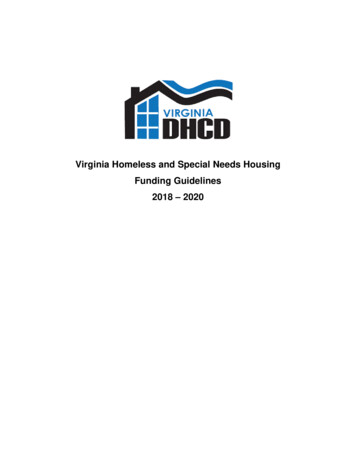
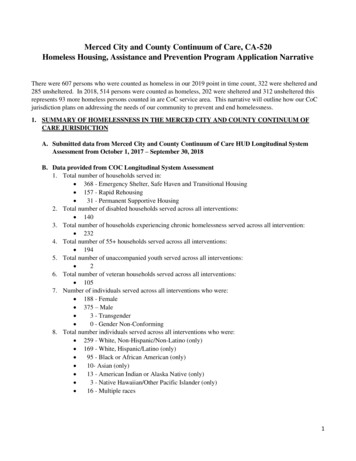
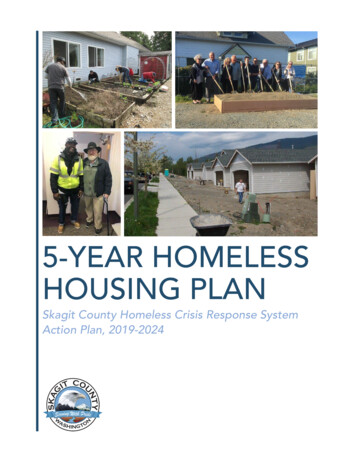
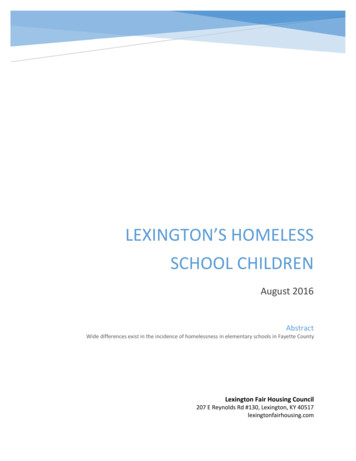

![Office 2010 Professional Plus Com Ativador Serial Keyl [EXCLUSIVE]](/img/61/office-2010-professional-plus-com-ativador-serial-keyl-exclusive.jpg)

